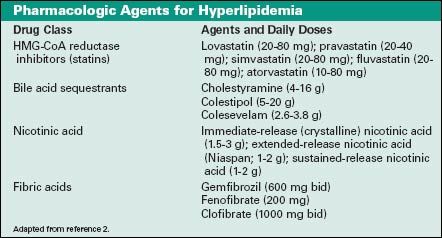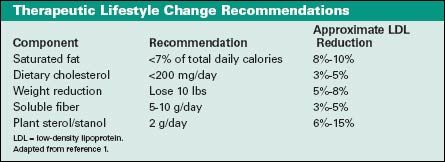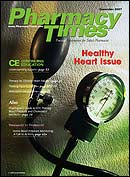Publication
Article
Pharmacy Times
Many Options Now Available to Treat Hyperlipidemia
Author(s):
Adherence to both pharmacologic and nonpharmacologic regimens will result in the largest impact on hyperlipidemia, and patients should be individually assessed to determine the most appropriate ones for them.
Mr. Mikhli is from the Arnold & Marie Schwartz College of Pharmacy and Health Sciences (AMS COP), Long Island University, Brooklyn, NY. Dr. Borowski is an assistant professor of pharmacy practice at AMS COP. Dr. Pham is an assistant professor of pharmacy practice at Western University of Health Sciences, College of Pharmacy, Pomona, Calif.
The body uses essential cholesterol to produce hormones, vitamin D, and bile acids to help digest fat. A small amount is required to perform these necessary functions, whereas excess cholesterol in the blood stream may lead to atherosclerosis which can result in angina and myocardial infarction. Hyperlipidemia is defined as the elevation of cholesterol, phospholipids, and triglycerides.
The relationship between elevated cholesterol and the development of coronary heart disease (CHD) is evident. Clinical evidence suggests that the risk for CHD-related events can be reduced by lowering low-density lipoprotein (LDL). Hence, primary goals of therapy and the point values for initiating nonpharmacologic and pharmacologic therapy are stated in terms of LDL.
The third report of the National Cholesterol Education Program (NCEP)1 to detect, evaluate, and treat high blood cholesterol in adults (Adult Treatment Panel [ATP] III) provides clinical guidelines for cholesterol testing and management. ATP III builds on previous ATP reports and expands the indications for intensive cholesterol-lowering therapy in clinical practice.
Pharmacologic Therapy
Many options are available for the treatment of hyperlipidemia (Table 1).2 The drugs employed have different mechanisms of action and are chosen based on which lipoprotein is being targeted. Statins, fibrates, cholesterol absorption inhibitors, nicotinic acid, and bile acid sequestrants can all be used to achieve patient-specific lipid goals.
Table 1

Statins (HMG-CoA reductase inhibitors) are the drugs of choice in patients presenting with elevated LDL due to their ability to reduce LDL by the greatest percentage— up to 60%. They have been proven safe and effective by the FDA with possible side effects such as headache, elevated liver enzymes, and muscle pain. Liver function tests (LFTs) must be monitored for patients on statin therapy. Another benefit of statins is that they can increase patients' high-density lipoprotein (HDL) levels while lowering triglyceride (TG) levels. Rosuvastatin has the longest half-life amongst statins.3 All statins should be taken at bedtime except for rosuvastatin and atorvastatin. Pravastatin is not metabolized by the CYP450 system and hence, has fewer drug interactions.3
It is important to tell patients to avoid grapefruit or grapefruit juice when taking lovastatin or atorvastatin because it will cause an increase in their bioavailability. Statins are contraindicated in patients with liver disease and are in pregnancy category X. Patients should notify their doctors immediately if they experience yellowing of the skin or eyes.
Zetia (ezetimibe) blocks cholesterol absorption that occurs from food consumption. Its unique mechanism affects the digestive tract and decreases the amount of cholesterol absorbed at the brush border of the small intestine. It can lower LDL by approximately 17%.4 When used in combination with simvastatin (Vytorin), it enhances its effect on LDL lowering. Side effects include myalgia and abdominal pain. It is important to monitor LFTs and signs and symptoms of cholelithiasis when used in combination with fenofibrate.
Bile acid sequestrants, including colestipol, cholestyramine, and colesevelam, are alternative agents which can reduce LDL 15% to 30%. They work by binding bile acids in the intestine and inhibiting reabsorption, thereby decreasing total blood cholesterol. They are commonly used as adjunctive therapy and in children because they are not absorbed and do not cause systemic toxicity.
The concern with these medications is the side effect profile and the possibility of drug interactions. Nausea, constipation, and flatulence are common adverse effects, and incidence increases with larger doses. Patients should increase their fiber and fluid intake to help manage these gastrointestinal (GI) side effects.5 Bile acid sequestrants may decrease the effectiveness of HMG-CoA reductase inhibitors, warfarin, digoxin, nicotinic acid, hydrochlorothiazide, and fat soluble vitamins. 5 Certain drugs should be spaced within at least 6 hours of each other to avoid drug interactions.5
Bile acid sequestrants are used in combination with statins or nicotinic acid to help decrease LDL. Combination therapy decreases GI side effects, because lower doses of bile acid sequestrants are used. Bile acid sequestrants can elevate TG levels, so they are contraindicated in patients with TG levels greater than 400 mg/dL.
Nicotinic acid works by blocking hepatic synthesis of very low-density lipoprotein (VLDL) and LDL. It also increases HDL levels by shifting the distribution of HDL subfractions and increasing apolipoprotein A-I content.6 Nicotinic acid is used mainly to decrease TG levels and increase HDL levels. TG levels can be decreased 30% to 50%, and HDL levels can be increased 20% to 35%.6
Side effects include hyperglycemia, hyperuricemia, hepatotoxicity, and flushing. Patients should take nicotinic acid with food and should start at low doses and titrate up to help minimize flushing. If patients experience flushing, aspirin 325 mg should be given 30 minutes before taking nicotinic acid.6 Nicotinic acid is contraindicated in patients with liver disease and severe gout. Alcohol should be avoided when taking nicotinic acid because it may worsen flushing.
Fibrates, including fenofibrate, gemfibrozil, and clofibrate, work by enhancing the breakdown of VLDL. They are used in the treatment of hypertriglyceridemia and can reduce TG levels 30% to 50%.4 Fibrates are an excellent choice for patients with diabetes because they improve glucose tolerance; gemfibrozil works best in diabetic dyslipidemia.7 These agents are recommended in patients with severe hypertriglyceridemia because they raise HDL levels 15% to 35%.
Side effects include myopathy, gallstones, and dyspepsia. Creatinine kinase and LFT elevations are frequently seen and should be closely monitored. These agents are not used in patients with severe liver or kidney disease or preexisting gallbladder disease. Fibrates can augment oral anticoagulants' effect, so patients' International Normalized Ratio levels should be monitored when these medications are used together.5
How Health Systems Choose Medication for Formulary
Health systems should review all classes of antihyperlipidemic medications individually. For example, statins should be evaluated for LDL-lowering potency, side effects, drug interactions, and cost. Health systems frequently will consider 2 statins to be placed on formulary based on the aforementioned criteria. For example, a certain statin may be very beneficial to prevent drug interactions with CYP450 but may have weak LDL-lowering potential. Furthermore, a certain statin may be very potent and have minimal drug interaction potential but may be costly in comparison with another statin. Subcommittees of the pharmacy and therapeutics committee should utilize primary research to find answers to the relative differences among medications.
Nonpharmacologic Therapy
Adopting healthy lifestyle choices is imperative in treating hyperlipidemia and in reducing CHD risk. NCEP recommends a multifaceted lifestyle approach entitled Therapeutic Lifestyle Changes (TLC) as nonpharmacologic treatment for hyperlipidemia. The TLC diet advises reduced intake of saturated fats and dietary cholesterol, increased intake of soluble fiber, addition of plant sterols/stanols, weight reduction, and increased physical activity. When followed intensely, the TLC diet reduces serum LDL cholesterol by 20% to 30%.1
The TLC diet is implemented at baseline and intensified every 6 weeks at follow- up visits. The TLC diet reduces parameters that increase serum LDL cholesterol levels, in particular, saturated fats and dietary cholesterol. Saturated fats are found in high-fat dairy products (whole milk, 2% milk, ice cream, cheese, butter, and cream), high-fat meats, and tropical oils (coconut oil and palm oil). Dietary cholesterol is found in dairy products, animal products, poultry, and shellfish.
The TLC diet also recommends increasing soluble fiber and initiating plant sterols/stanols for enhancing LDL cholesterol reduction. Sources of soluble fiber include oats, guar, pectin, and psyllium. Plant sterols/stanols, obtained from soybeans and pine tree oils, are often found in margarines; therefore, calories from these products must be taken into consideration when added to daily diets.1
Table 2

Emphasis on weight reduction and increased physical exercise to reduce LDL cholesterol is provided after dietary habits are assessed. This keeps new patients from becoming overloaded with information. Any weight loss (ie, 10 lbs or 10% from baseline) and moderate physical activity (30 minutes a day for most days of the week) reduces LDL cholesterol and CHD risk. Table 2 lists the key daily recommendations of the TLC diet and corresponding LDL reductions.1
Conclusion
Many pharmacologic therapies exist in the treatment of hyperlipidemia. Each drug class works by different mechanisms to produce effects on different lipoproteins. As a result, each drug class exemplifies different adverse drug reactions and is contraindicated in specific co-morbidities. Patients should be individually assessed to determine the most appropriate medication regimen. Additionally, all patients should undergo lifestyle modifications with the TLC diet, focusing on reducing saturated fats and dietary cholesterol, increasing soluble fiber and plant sterols, and achieving weight loss. Adherence to both pharmacologic and nonpharmacologic regimens will result in the largest impact on hyperlipidemia.
Case Scenarios
- JP is a 34-year-old white woman with hypertension and hyperlipidemia. She presents to the clinic for a follow-up of hyperlipidemia. JP is confirmed to be pregnant as of yesterday. She is currently on an antihypertensive medication and simvastatin 20 mg po every night. Her lipid profile is as follows: Total cholesterol = 177 mg/dL Triglycerides = 189 mg/dL High-density lipoprotein = 30 mg/dL Low-density lipoprotein = 89 mg/dL Which of the following choices is the best to recommend for JP? Increase simvastatin dose to 40 mg po every night Decrease simvastatin dose to 10 mg po every night Simvastatin should be taken with breakfast rather than every night Discontinue simvastatin
- HP is a 55-year-old man with newly diagnosed hyperlipidemia. HP?s other comorbidities include hypertension, asthma, and cholelithiasis. HP?s doctor initiates Lipitor (atorvastatin calcium) 20 mg qd and refers HP to your clinic for education on the Therapeutic Lifestyle Changes (TLC) diet. Which of the following is not a component of the TLC diet? Decreased consumption of saturated fats Decreased consumption of plant sterols Increased consumption of soluble fiber Weight loss
Answers
- d. Discontinue simvastatin
- b. Decreased consumption of plant sterols
Click to Read Answers for Case Scenarios: Hyperlipidemia
function showAnswer() {document.getElementById("answer").style.display = 'block';document.getElementById("link").style.display = 'none';}
References
- Executive Summary of the Third Report of the National Cholesterol Education Program (NCEP) Expert Panel on Detection, Evaluation, and Treatment of High Blood Cholesterol in Adults (Adult Treatment Panel III). JAMA. 2001;285:2486-2497.
- National Heart Lung and Blood Institute. National Institutes of Health. ATP III At-A-Glance: Quick Desk Reference. Available at: www.nhlbi.nih.gov/guidelines/cholesterol/atglance.pdf.3. Bottorff M, Hansten P. Long-term safety of hepatic hydroxymethyl glutaryl coenzyme A reductase inhibitors: The role of metabolism monograph for physicians. Arch Intern Med. 2000;160:2273-2280.
- Third Report of the National Cholesterol Education Program (NCEP) Expert Panel on Detection, Evaluation, and Treatment of High Blood Cholesterol in Adults (Adult Treatment Panel III). Available at: www.nhlbi.nih.gov/guidelines/cholesterol/atp3full.pdf. Accessed June 22, 2007.
- Dipiro J, Talbert R, Yee G, Matzke G, Wells B, Posey L, eds. Hyperlipidemia. In: Pharmacotherapy: A Pathophysiologic Approach Sixth Edition. New York: McGraw-Hill; 2005: 439-49.
- Wolters Kluwer Health Web site. Available at: online.factsandcomparisons.com/search.aspx?search=Nicotinc%20acid. Accessed July 23, 2007.
- Huttunen JK, Manninen V, Manttari M, et al. The Helsinki Heart Study: central findings and clinical implications. Ann Med. 1991;23:155-159.







